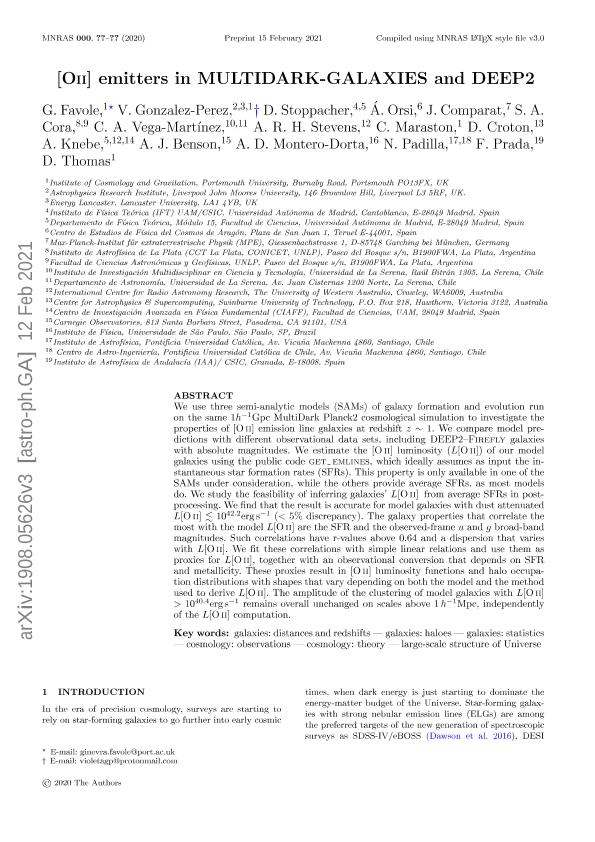Artículo
[O ii] emitters in MultiDark-Galaxies and DEEP2
Favole, G; González Pérez, Carlos Federico ; Stoppacher, D; Orsi, Á; Comparat, J; Cora, Sofia Alejandra
; Stoppacher, D; Orsi, Á; Comparat, J; Cora, Sofia Alejandra ; Vega Martínez, Cristian Antonio
; Vega Martínez, Cristian Antonio ; Stevens, A. R. H.; Maraston, C.; Croton, D.; Knebe, A.; Benson, Silvia; Montero Dorta, A. D.; Padilla, Natalia Soledad
; Stevens, A. R. H.; Maraston, C.; Croton, D.; Knebe, A.; Benson, Silvia; Montero Dorta, A. D.; Padilla, Natalia Soledad ; Prada, Federico; Thomas, Pablo Daniel
; Prada, Federico; Thomas, Pablo Daniel
 ; Stoppacher, D; Orsi, Á; Comparat, J; Cora, Sofia Alejandra
; Stoppacher, D; Orsi, Á; Comparat, J; Cora, Sofia Alejandra ; Vega Martínez, Cristian Antonio
; Vega Martínez, Cristian Antonio ; Stevens, A. R. H.; Maraston, C.; Croton, D.; Knebe, A.; Benson, Silvia; Montero Dorta, A. D.; Padilla, Natalia Soledad
; Stevens, A. R. H.; Maraston, C.; Croton, D.; Knebe, A.; Benson, Silvia; Montero Dorta, A. D.; Padilla, Natalia Soledad ; Prada, Federico; Thomas, Pablo Daniel
; Prada, Federico; Thomas, Pablo Daniel
Fecha de publicación:
10/2020
Editorial:
Wiley Blackwell Publishing, Inc
Revista:
Monthly Notices of the Royal Astronomical Society
ISSN:
0035-8711
Idioma:
Inglés
Tipo de recurso:
Artículo publicado
Clasificación temática:
Resumen
We use three semi-analytical models (SAMs) of galaxy formation and evolution run on the same 1 h−1 Gpc MultiDark Planck2 cosmological simulation to investigate the properties of [O II] emission line galaxies at redshift z ∼ 1. We compare model predictions with different observational data sets, including DEEP2–FIREFLY galaxies with absolute magnitudes. We estimate the [O II] luminosity (L[O II]) of our model galaxies using the public code GET EMLINES , which ideally assumes as input the instantaneous star formation rates (SFRs). This property is only available in one of the SAMs under consideration, while the others provide average SFRs, as most models do. We study the feasibility of inferring galaxies’ L[O II] from average SFRs in post-processing. We find that the result is accurate for model galaxies with dust attenuated L[O II] 1042.2 erg s−1 (< 5 per cent discrepancy). The galaxy properties that correlate the most with the model L[O II] are the SFR and the observed-frame u and g broad-band magnitudes. Such correlations have r-values above 0.64 and a dispersion that varies with L[O II] . We fit these correlations with simple linear relations and use them as proxies for L[O II] , together with an observational conversion that depends on SFR and metallicity. These proxies result in [O II] luminosity functions and halo occupation distributions with shapes that vary depending on both the model and the method used to derive L[O II] . The amplitude of the clustering of model galaxies with L[O II] >1040.4 erg s−1 remains overall unchanged on scales above 1 h−1 Mpc, independently of the L[O II] computation.
Archivos asociados
Licencia
Identificadores
Colecciones
Articulos(IALP)
Articulos de INST.DE ASTROFISICA LA PLATA
Articulos de INST.DE ASTROFISICA LA PLATA
Citación
Favole, G; González Pérez, Carlos Federico; Stoppacher, D; Orsi, Á; Comparat, J; et al.; [O ii] emitters in MultiDark-Galaxies and DEEP2; Wiley Blackwell Publishing, Inc; Monthly Notices of the Royal Astronomical Society; 497; 4; 10-2020; 5432-5453
Compartir
Altmétricas



